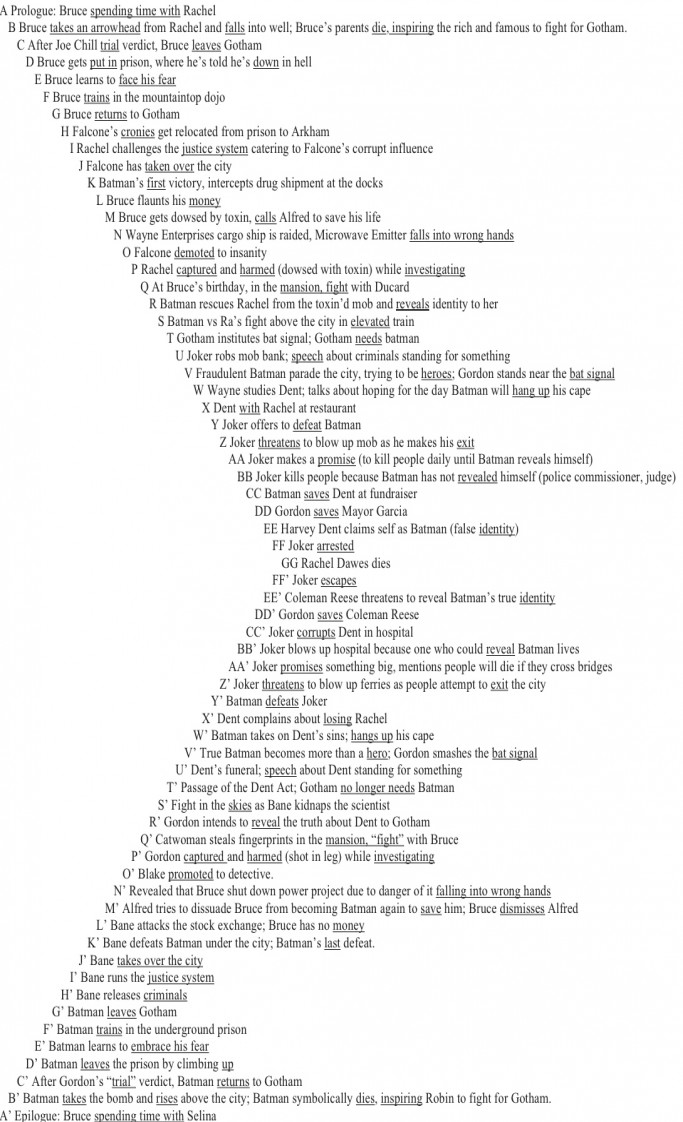Douglas Jordan came up with the following structure of the Dark Knight Trilogy, and, since he doesn’t have a blog, he gave me permission to reproduce it here. Due to significant formatting issues, I had to insert the chiasm as a JPEG, so my apologies regarding the clarity and the ongoing formatting issues below it. I have also added a few further observations that Doug made as part of an online discussion of his proposed chiasm. Enjoy.

I missed an obvious entry. Between B & C, we have Gordon comforting Bruce after his parents die. Between C’ and B’, we have Batman referring to this event. Even have a flashback.
It’s no coincidence that there’s a prison at the beginning and end of the story, or that Batman’s trapped down a well (we even get a flashback to his childhood). His descent into the underground prison is clearly intended to mirror his ascent to the mountaintop. On the mountain, he learned Al Ghul had a wife. In the underground prison, he learns about Al Ghul’s child, and there’s a flashback to the mountaintop scene where he first learned about the wife. Also, a vision of Al Ghul approaches him in the prison, just like the living Al Ghul visited him in prison in the first film.
The flashback with Gordon putting his coat around Bruce is clearly intentional (in order to comfort Gordon, Batman reminds him of the way that Gordon once comforted him), and the inspiration caused by his parent’s death and Batman’s “death” mirror each other well.
I think it’s also
intentional that in both the first and third movie Wayne Enterprises technology falls into the wrong hands and threatens the city.
In the second movie, the contrast between Dent’s character at the beginning and end of the film is clearly intentional — that’s why in the final sequence Batman repeats the phrase that Dent said in the very early restaurant scene, “You either die a hero or live long enough to see yourself become the villain.” I suspect having the bat signal so near the beginning of the film and the end is also intentional.
The third movie makes it very clear that the turning point of Batman’s career is Rachel’s death.
My chiasm might be a bit too detailed, and probably works better at a higher level. For example, I find the parallel between Falcone’s insanity and Blake’s promotion to be a bit forced. 🙂
Anyway, one of Nolan’s mastered skills is flashbacks (every Nolan movie I’ve ever seen has a number of them), so at the end of his movies he wants us to be remembering what happened at the beginning, and I think he was very deliberate to do it for the trilogy as a whole in the latest film.
Just had another thought about the parallels between the dinner scene and the final scene of The Dark Knight:
Dent: When their enemies were at the gates the Romans would suspend democracy
and appoint one man to protect the city. lt wasn’t considered an honor,
it was a public service.
Rachel: Harvey, the last man that they appointed to protect the republic was named Caesar and he never gave up his power.
Dent: Okay, fine. You either die a hero or you live long enough to see yourself become the villain.
Caesar was one of three members of the First Triumvirate. I wonder if Nolan had this in mind with this exchange near the end of the film:
Batman: You don’t wanna hurt the boy, Harvey.
Dent: lt’s not about what I want, it’s about what’s fair! You thought we could be decent men
in an indecent time. But you were wrong. The world is cruel. And the only morality
in a cruel world is chance. Unbiased. Unprejudiced. Fair. His son’s got the same chance she had. Fifty-fifty.
Batman: What happened to Rachel wasn’t chance. We decided to act. We three.
“We three.” Another Triumvirate.